Mindset
Cross-Curricular Ties
Health: positive body image and regular exercise
Language Arts: The power of ideas in Literature that help formulate new understanding and growth.
Science: experimentation/ new discovery
Mathematics: problem solve, play with puzzles, understand that what you don't understand now will come to you eventually
Social Studies: explore different cultural focuses/mindsets e.g. family, career, education, military
Developmental Attributes
Gender
Male
Activities focused on student engagement. Activities with a focus on Competition, movement, and rewards.
Female
Activities focused around social interactions and skills. Activities that have reason and help to increase student participation.
Gender Neutral Trends
Piagetian developmental level
Blend of Concrete operations and Formal Operations
Vygotskian considerations
Begin with self talk and progress to internalization. Differentiate Scaffolding.
Students between the ages of 10 and 14
Interests
Students interests: Experimenting, Social interactions, References to former knowledge.
Attention Span
10 to 15 minutes of activity with no changes in the activity.
Relevance to prior Knowledge
Helping students draw connections to their life can be an effective tool for creating strong links between knowledge and a new understanding.
Having a positive/growth mindset affects success and learning in the classroom
Cultural mindset
The United States Mindset on Family
Defining Feature:
Non-Examplars:
Prototype:
Possible Misconceptions
Under-generalizations:
Over-generalization:
Assessment
